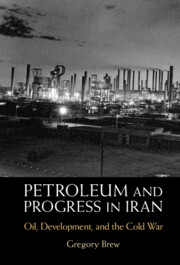Book contents
- Petroleum and Progress in Iran
- Petroleum and Progress in Iran
- Copyright page
- Dedication
- Contents
- Figures
- Acknowledgments
- Note on Transliteration
- Abbreviations
- Introduction
- Part I
- 1 Iran, Global Oil, and the United States, 1901–1947
- 2 “We Have Done Nothing”
- 3 The Mosaddeq Challenge
- 4 The Collapse Narrative
- Part II
- Bibliography
- Index
2 - “We Have Done Nothing”
The Seven-Year Plan and the Failure of Dual Integration in Iran, 1947–1951
from Part I
Published online by Cambridge University Press: 15 December 2022
- Petroleum and Progress in Iran
- Petroleum and Progress in Iran
- Copyright page
- Dedication
- Contents
- Figures
- Acknowledgments
- Note on Transliteration
- Abbreviations
- Introduction
- Part I
- 1 Iran, Global Oil, and the United States, 1901–1947
- 2 “We Have Done Nothing”
- 3 The Mosaddeq Challenge
- 4 The Collapse Narrative
- Part II
- Bibliography
- Index
Summary
In the wake of the Azerbaijan Crisis, the United States supported the Pahlavi development program, the Seven-Year Plan, masterminded by Abolhassan Ebtehaj, the country’s premier developmentalist. Assistance came from proxy groups, particularly the World Bank. The bank neglected to provide loans until Ebtehaj and the shah agreed to place the plan under foreign management. Primary financial support for the plan was to come from the Anglo-Iranian Oil Company. But negotiations failed to produce an agreement that would increase Iran’s revenues. The rise of an Iranian petro-nationalist movement, an economic crisis, and political paralysis within the Pahlavi government coalesced in 1950, and despite a late intervention the United States and its allied proxies failed to rescue the plan or the shah’s government from succumbing to the nationalization campaign of nationalist leader Mohammed Mosaddeq in early 1951.
- Type
- Chapter
- Information
- Petroleum and Progress in IranOil, Development, and the Cold War, pp. 53 - 85Publisher: Cambridge University PressPrint publication year: 2022

